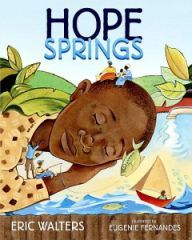Hope Springs
 Hope Springs
Hope Springs
Picture book / Elementary
Tundra Books
2014
Unpaged
ISBN 978 1 77049 530 2

A drought has settled in the area around the orphanage where Boniface lives. There are long line-ups at the tiny spring where all the local people get their water, and suddenly the orphans are pushed to the back of the line, unwelcome. Boniface's houseparent, Henry, tells him that the people were mean out of fear--they feared there would not be enough water for their families. When the building of the orphanage's well is completed, Boniface has an idea to help the villagers. A lovely story of kindness and heart, this story shows that, through compassion and understanding, true generosity can spring from unexpected places.
Eric Walters paraphrases a segment of his own philanthropic life through Hope Springs a brightly illustrated picture book set in Mbooni, a semi-arid district in Kenya. Through the eyes of a child, the story line describes the challenges of living in rural Kenya where access to basic everyday necessities like water are at times very challenging. If it rains, water is plentiful. When the rains fail, everyone has to rely on a small spring for all their needs. It can take hours just to fill a bucket as the water comes in “little trickles” “drop by drop.”
The main character, Boniface, lives in an orphanage with his twin brother and several other children. The orphanage is in the process of digging a well to meet their water needs. When a drought hits before the well is completed, the boys have to find other sources of water. They walk a mile to collect water at a little spring where everyone gathers. Afraid that their only source of water is being ‘invaded’ by children “who may live here, but …are not from here,” the village women chase Boniface and the kids away. This saddens Boniface and intensifies his anxiety. He dreams “of a place where there [is] enough water for everyone.” After weeks of hardship, the well is completed and water comes forth in plenty! Boniface is happy but he worries that “the people in the valley have so little.” True to his kind self, he urges his house parent to help the villagers construct a well around the spring. They do, and the end result is “enough water–and enough kindness–for all.”
This is a heart-warming story of kindness, generosity, resilience and brotherhood in the context of scarce resources, poverty and the other everyday struggles of people in Mbooni. Boniface, the protector, is caring, thoughtful and compassionate. He teaches the reader that it is always our responsibility to make the world a better place especially when we have the resources to do so.
In the author’s note, there are photos of the real Boniface and his siblings. Walters explains that Hope Springs is based on an incident that really occurred when children from the orphanage sought water during a drought. Creating a story based on a real event makes the narrative compelling and authentic.
Hope Springs is illustrated by Eugenie Fernandes who illustrated My Name is Blessing (2013) also by Walters and also set in Kenya. Her colorful pictures are lively and energetic. Although she paints a picture of a poverty-stricken people–the typical stereotype about Africa–she manages to show poverty without stereotyping the people. My only quibble is the book’s typeface is small in contrast to Fernandes’ bold illustrations. A larger text would be easier on the eye of the reader.
I highly recommend this book to all. There are universal lessons and truths about sharing and caring with those around us who have limited resources, are going through the scarcity of basic needs, or need our lending hand. The primary message is an old one, we are our brother’s keeper.
Reviewed by Jane Irungu Ph.D. University of Oregon
Published in Africa Access Review (February 17, 2015)
Copyright 2015 Africa Access
